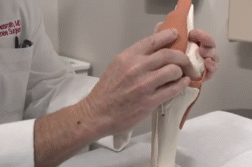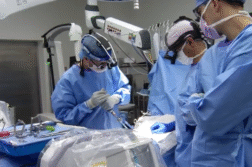Georgiy Brusovanik, MD, Orthopedic Spine Surgeon talks about fixing failed spine surgeries.
Interview conducted by Ivanhoe Broadcast News in 2024.
People think, “I’m going to go get a back surgery and I’m going to be healed.” Is that really okay?
Brusovanik: Yeah, it’s a bit of a scourge. There is a really good study out of University of Miami where they looked at spine surgery patients, all in comas, and specifically with fusions, which has become one of the most common spinal operations. There is a 36% failure rate, meaning that over a third of patients who have the big old classic spine surgery will end up going back for more surgery.
Do you have any more stats on how, or even when it’s not spinal fusion that 50% really don’t get any better?
Brusovanik: Absolutely.When it comes to a diskectomy, which is a very common procedure for patients who have severe sciatica pain going down the leg, 9% of these patients, whether you use the classic technique or the sparing technique, will re-herniate, meaning that you sneak in, you remove a little piece of disc that’s hurting their nerve, they wake up and their pain is gone. However, a percentage of them will have the herniation come right back. And it’s important to address their pain as opposed to just pacifying by saying, “Try more physical therapy or it’s just inflammation.” These patients deserve a diagnosis. Now, newer more advanced spine surgery like disc replacement and newer techniques at fusion have really helpled to provide solutions to this terrible issue of reoperations. As such,the rate of reoperation has gone down to 3% with some of the newer techniques. But the majority of spine surgery that’s done throughout the United States – and definitely throughout the world- is the big, wide open, classic spine surgery. So the number of patients who have had that kind of spine surgery and who are still suffering is a very high number.
So other patients that you see that have revision back surgery, would you say they’re mostly spinal fusion and then reherniated disc, is there another one that you see mostly?
Brusovanik: No. I think those represent the vast majority. They represent good quality surgeries performed well that still failed. Now, the number of patients who’ve had spine surgery and are still suffering is actually higher, partly because there’s also a high number of patients who have either had bad spine surgery that was not indicated, surgery at the wrong level, or the surgery that was way too aggressive as compared to what they actually needed. So, again the number of patients who’ve had spine surgery and who are still suffering is very high.
Why does a good spine surgery go bad?
Brusovanik: So in the best of hands, when classic spine surgery is performed, there are still trade offs that go along with that approach. For example, classic spine surgery involves placing screws in a way that damages the proximal level. So frequently you’ll hear from patients that had a fusion and now they have a problem above, or they have a problem below. In the best of hands, this still happens to about 12%, and this isn’t an issue with the hands or the skill of the surgeon, this has to do with the old approach.
Got it now. They call this FBSS, right?
Brusovanik: That’s right. Failed back surgery syndrome.
Tell me, what is failed back surgery syndrome?
Brusovanik: Failed back surgery syndrome essentially describes all patients who have had spine surgery and are continuing to suffer. Now in that group, there is a sub-group that have a similar acronym, and it stands for flat back syndrome. And that refers specifically to patients who have had a fusion performed in a classic way, a fusion that leaves patients in what’s called a forward, flexed, or kyphosed position. And these patients are at an even higher risk of having a problem re-occur.
Would you say most of your practice, right now, that you do, is revision back surgery?
Brusovanik: Yes, the vast majority of what I do, over 80%, are taking care of patients who have already had spine surgery. They have gone back to their spine surgeon or were so disheartened they didn’t even go back, and they continued to suffer. These are the patients who I love to help the most.
And so talk to me about Mr. Viola. Is there anything to say about Viola?
Brusovanik: Yes.
Tell me about him when you first saw him.
Brusovanik: So he came in with classic symptoms associated with a disc herniation. He was flexed forwards, he couldn’t really walk very well. He had severe pain going down his right leg, and when we obtained an MRI, we found that there was a large disc herniation compressing a nerve that goes down his leg. So this man was very functional, very active, and he was rendered essentially handicapped by the severity of his pain. The pain was constant, he couldn’t sleep, he couldn’t lay down, he couldn’t sit, he couldn’t walk. And even though we tried all the conservative means like physical therapy and epidural steroid injections, he continued to suffer. In fact, he was feeling worse.
What did you do for him?
Brusovanik: I performed a minimally invasive diskectomy, or what’s called a micro diskectomy, where you sneak in, carefully protect the nerve, and remove the little piece of disc that has exited the disc proper into the canal and was compressing his nerve. I removed that fragment and carefully closed the wound.
Now, those activities, are those common now?
Brusovanik: It’s a very common operation. I would say somewhat overdone when it’s performed for patients who have degenerative discs. But in his case, as a young man with very specific pathology, meaning that there was a large fragment of disc that was sitting in the canal. In that situation, a diskectomy is actually very effective and well indicated.
Can you explain that more?
Brusovanik: Absolutely. In minimally invasive surgery, we avoid making a big hole and then just looking around. Everything is very focused,
The incision, was it like an inch?
Brusovanik: It’s a very small incision and we use a fluoroscope to center the incision right over the side of the herniation. I use tubular retractors to avoid damaging muscle in any way, and that allows me to get into the canal without causing much damage to the back. Then you enter the spinal canal. You immediately find all the important structures and carefully protect them. And as you retract the nerve out of the way, you can see that there’s a piece of a fragment of almost like a foreign body that sits right beneath it. You remove that fragment, irrigate thoroughly, and then carefully close the wound.
Do you see the risk of that slipping out again?
Brusovanik: Yes, there are a number of studies that provide us different statistics as far as what the chances are of it coming back. But I’d like to quote this one particular study out of Stanford where the rate is about 9%.
It’s pretty good chance that you’re going to have pain for your life, right?
Brusovanik: Yes and really, it’s not anything to blame the patient for. Some patients have these reherniations after a cough or sneeze, or after lifting their cat. So I really don’t like when the patients get blamed for this, it’s not their fault.
Let’s say you are a patient that had a failed back surgery. Maybe you could tell me three of the questions you should be asking your doctor about revision.
Brusovanik: So number 1 most important question is to ask the doctor, why am I suffering? And the answer has to be satisfactory. It can’t be general. The modes of failure are very few. So you should hear something in the realm of, there’s a problem above your fusion or your fusion did not stick. Those are the two most common causes and describe probably about 90% of surgical failure. If the doctor knows why you are suffering, then he has a very good chance of fixing the problem. The second question is, are you experienced in dealing with this kind of a problem? Now look, most spine surgeons will likely say that they are experienced, but then it’s reasonable to ask, can I talk to a patient of yours that you have fixed or helped recently that has undergone this exact problem? I think that most successful spine surgeons, who in honesty perform a lot of revisions, will be very forthcoming in offering up a patient for you to talk to . If this surgeon has a good rapport with his patients, there shouldn’t be much difficulty in arranging that conversation. Lastly, if you feel that the surgeon is blaming you for what happened, I think it’s important to address that issue. Patients should not feel like they are being blamed for the failure of the operation, and the treatments that are going to address their ongoing pain must be very much tailored to the problem. Just telling a patient, go to therapy and they continuetherapy for months and months on end without improvement is futile. I think it hurts patients further, not only physically, but also in terms of their morale. I think it’s important to consider the patient’s morale when they have undergone a big spinal operation and they’re continuing to suffer. So I would say that it has to be a very brave conversation and unfortunately, if a patient does not feel like he or she is being provided forthcoming clear answers, I think it’s reasonable to search for a spine surgeon that specializes in revisions.
Do you think I missed anything? Do you have anything to add?
Brusovanik: So an important note is when did the pain begin again. A spine surgeon who is well versed in revision will likely ask the patients when did the pain begin. It makes a difference. For example, in Renato’s case, his pain reoccurred about a month after surgery. Instead of just blaming him or his hard work, instead of saying you didn’t do enough physical therapy, I obtained a. new MRI immediately, and the diagnosis was apparent. With a new MRI, itwas obvious that another piece of disc had snuck out and was once again compressing his nerve. That knowledge is what allowed me to take the next step and to help him to revise the diskectomy and to get him back to 100%. The goal of spine surgery should be to get to 100% functionality It’s important that patients feel encouraged. A back problem is no different than a knee or a hip problem. If the joint or the area hurts, there’s usually, 99% of the time there’s an obvious cause and it’s very important to ascertain that cause and address it directly, if a revision is indicated.
END OF INTERVIEW
This information is intended for additional research purposes only. It is not to be used as a prescription or advice from Ivanhoe Broadcast News, Inc. or any medical professional interviewed. Ivanhoe Broadcast News, Inc. assumes no responsibility for the depth or accuracy of physician statements. Procedures or medicines apply to different people and medical factors; always consult your physician on medical matters.
If you would like more information, please contact:
Georgiy Brusovanik, M.D.
Sign up for a free weekly e-mail on Medical Breakthroughs called First to Know by clicking here




